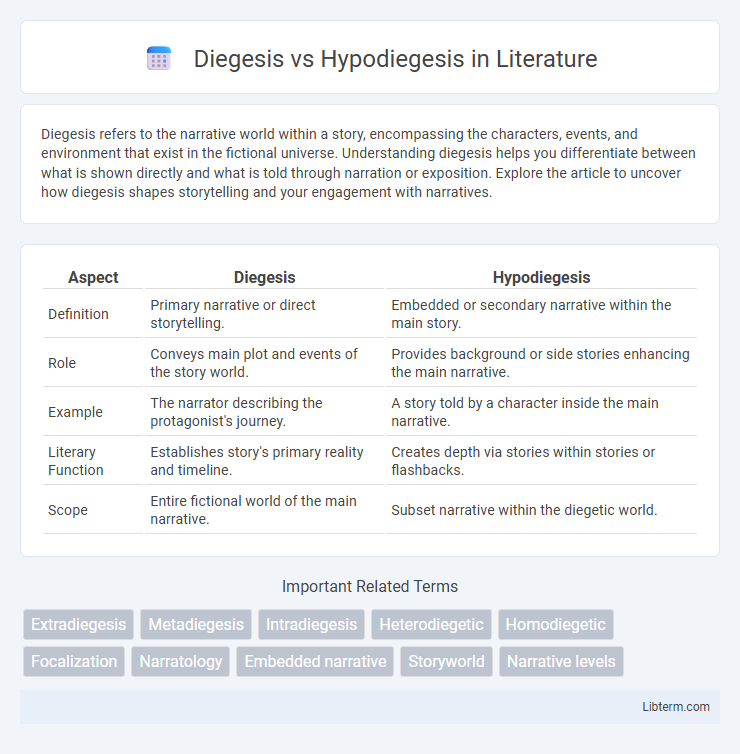Diegesis refers to the narrative world within a story, encompassing the characters, events, and environment that exist in the fictional universe. Understanding diegesis helps you differentiate between what is shown directly and what is told through narration or exposition. Explore the article to uncover how diegesis shapes storytelling and your engagement with narratives.
Table of Comparison
| Aspect | Diegesis | Hypodiegesis |
|---|---|---|
| Definition | Primary narrative or direct storytelling. | Embedded or secondary narrative within the main story. |
| Role | Conveys main plot and events of the story world. | Provides background or side stories enhancing the main narrative. |
| Example | The narrator describing the protagonist's journey. | A story told by a character inside the main narrative. |
| Literary Function | Establishes story's primary reality and timeline. | Creates depth via stories within stories or flashbacks. |
| Scope | Entire fictional world of the main narrative. | Subset narrative within the diegetic world. |
Understanding Diegesis: Definition and Scope
Diegesis refers to the narrative world in which characters, events, and settings exist, encompassing everything that the story explicitly presents to the audience or readers. It defines the internal reality of a story, including both objective and subjective elements experienced by the characters. Understanding diegesis involves recognizing its scope as the complete fictional universe where the narrative unfolds, distinct from hypodiegesis, which deals with embedded or secondary narratives within that larger framework.
Introducing Hypodiegesis: What Lies Beneath the Narrative
Hypodiegesis reveals a deeper narrative layer embedded within the main diegesis, often functioning as a story within the story. This technique enhances the complexity of the plot by introducing subordinate fiction or subjective experiences that inform the primary narrative. Exploring hypodiegetic elements uncovers hidden meanings and enriches the audience's understanding of character motivations and thematic depth.
Key Differences Between Diegesis and Hypodiegesis
Diegesis refers to the narrative world presented directly by the storyteller, encompassing all events and characters within the primary story framework, while hypodiegesis denotes a secondary, embedded narrative or story within the main diegesis. The key difference lies in their narrative levels: diegesis forms the main fictional universe, whereas hypodiegesis operates as an internal subplot or fictional story existing inside that universe. Analyzing diegesis and hypodiegesis reveals how storytellers structure complex narratives through framing stories and subsidiary tales to enrich thematic depth and character development.
The Role of Narrators in Diegetic and Hypodiegetic Levels
Diegetic narrators operate within the primary narrative world, guiding the audience through events experienced by characters, while hypodiegetic narrators function within subordinate or embedded narratives, often providing stories within stories. The role of narrators in diegetic levels involves shaping the main plot and character perspectives, whereas in hypodiegetic levels, narrators add layers of meaning and complexity by presenting alternative viewpoints or additional contexts. This distinction is crucial for understanding narrative structure and the manipulation of storytelling perspectives in literature and media.
Diegesis in Literature and Cinema: Examples and Functions
Diegesis in literature and cinema refers to the narrative world where characters, events, and settings exist, encompassing all elements that form the story's reality. In films like "Inception," diegetic sounds such as dialogue and ambient noise immerse viewers within the story world, while narrators in novels like "Moby-Dick" guide readers through the plot using diegetic narration. Functions of diegesis include establishing the story's internal logic, enhancing audience immersion, and distinguishing between on-screen reality and external storytelling devices.
Exploring Hypodiegetic Narratives in Storytelling
Hypodiegetic narratives operate within a secondary story embedded inside the primary diegetic world, offering layers of meaning and complexity that enrich the overall storytelling experience. These embedded narratives often reveal character motivations, cultural contexts, or thematic subtexts by shifting perspectives without breaking the diegetic boundary. Exploring hypodiegetic structures enables creators to craft multifaceted stories that engage audiences through interconnected plotlines and nuanced world-building.
How Hypodiegesis Shapes Sub-Narratives
Hypodiegesis shapes sub-narratives by embedding secondary stories within the primary narrative, often providing alternative perspectives or deeper context that enriches the overall plot structure. This nested storytelling technique allows audiences to engage with multiple layers of meaning, enhancing thematic complexity and character development. The strategic use of hypodiegesis creates a multifaceted narrative experience by juxtaposing different voices and temporalities within the diegetic world.
Diegesis vs Hypodiegesis: Impact on Reader Engagement
Diegesis involves a narrator directly conveying the story's events and context, fostering a more immersive and authoritative reader experience. Hypodiegesis, by embedding stories within stories, creates layered narratives that enhance reader curiosity and engagement through complex perspectives. The interplay between diegesis and hypodiegesis deepens narrative texture, influencing how readers perceive and emotionally connect with the text.
Analyzing Multi-Layered Narratives: Diegesis and Hypodiegesis
Diegesis refers to the primary narrative framework where the story is directly told by a narrator, establishing the main reality within the text. Hypodiegesis operates as a secondary narrative embedded within the diegetic world, often manifesting as stories told by characters inside the main story, creating a layered or nested narrative structure. Analyzing these multi-layered narratives highlights how hypodiegetic levels enrich the overall plot by adding depth, complexity, and diverse perspectives to the diegetic core.
Practical Tips for Writers: Navigating Diegesis and Hypodiegesis
Writers can enhance storytelling by clearly distinguishing diegesis, the narrated world itself, from hypodiegesis, the embedded or secondary narratives within it. Practical tips include using diegesis to establish the primary story framework while leveraging hypodiegesis for subplots, flashbacks, or character backstories to enrich the narrative without disrupting the main timeline. Maintaining clear narrative boundaries and purposeful transitions helps readers navigate between these layers, enhancing story immersion and coherence.
Diegesis Infographic

 libterm.com
libterm.com